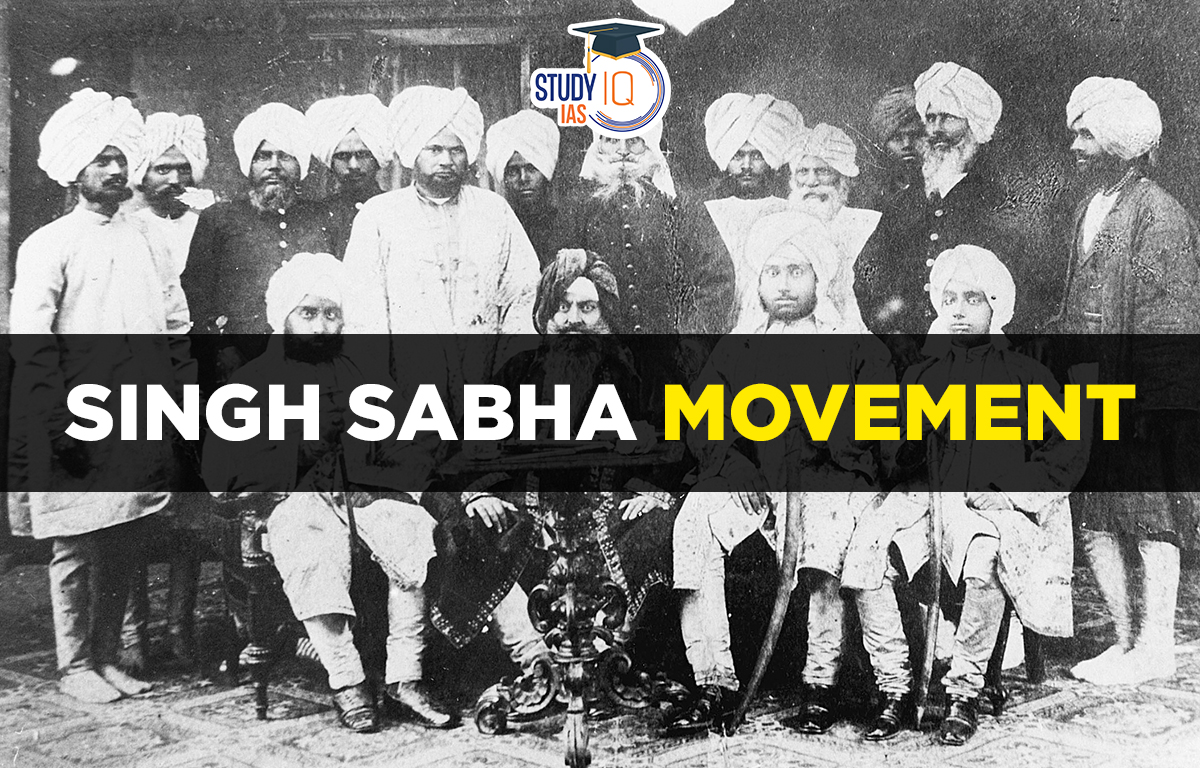Table of Contents
Singh Sabha Movement
In response to Muslim, Christian, and Hindu reform movements (Brahmo Samajis, Arya Samaj), the Singh Sabha Movement was founded in Punjab in the 1870s (Aligarh movement and Ahmadiyah). The movement was started at a period when the Sikh Empire had been dismantled and conquered by the British, the Khalsa had lost its reputation, and the majority of Sikhs were quickly converting to other religions.
In order to “promote the authentic Sikh religion and restore Sikhism to its original grandeur,” the organization wrote and distributed Sikh historical and religious publications. It also worked to spread Gurmukhi Punjabi through magazines and other media. As you study for the UPSC Civil Service Exam, this article will provide you with information on the Singh Sabha that will be helpful.
Read More: Temple Entry Movement
Singh Sabha Movement History
The first Singh Sabha was founded in Amritsar as a result of a chain of events. The Sikh community has been shook by the Namdhari turmoil, Shraddha Ram’s statements, and Christian conversions. In the early months of 1873, a number of Sikh pupils at Amritsar Mission School professed their conversion to Christianity. The Singh Sabha of Amritsar was founded as a result of this occurrence, and its first meeting was held on October 1, 1873.
Those who helped form the Sabha were Sir Khem Singh Bedi, Thakur Singh Sandhawalia, Kanwar Bikram Singh of Kapurthala, and Giani Gian Singh. Giani Gian Singh was chosen as secretary, while Sandhawalia was chosen as president. The Sabha wanted to bring Sikhism back to its former purity, produce historical religious works, publications, and journals, spread information in Punjabi, bring back apostate Sikhs to their original faith, and include high-ranking Englishmen in the Sikh educational system.
A vice-president, an assistant secretary, a giani (a Sikh scripture scholar), an updeshak (a preacher), a treasurer, and a librarian were among the new officers added as the Sabha grew in size. Members had to be ardent adherents of the gurus’ teachings and be Sikhs. They were invited to vow their allegiance to Sikhism and to give back to the community in exchange for a monthly fee.
All of the founding members were baptised Sikhs, despite the Sabha’s constitution’s lack of a necessity. The Sabha started publishing records of its decisions right away, and each one was approved by a majority. Additionally, the Sabha maintained records of its earnings and outlays and released annual reports.
Read More: Reform Movements by Parsi
Singh Sabha Movement Feature
In 1873, the year after the Kukas were persecuted and their movement was put down, the Singh Sabha Movement was established. With a considerably wider appeal among the Sikh masses, the Singh Sabha movement and its initiatives had a much greater influence. The majority of the educated middle class supporters of the Singh Sabha movement were also involved in other socio-religious organizations in Punjab.
They were also aware of movements of a similar nature taking place in other regions of the nation. They held that a lack of education was to blame for the societal ills affecting Sikhs. They believed that only by educating the populace about their forebears could social and religious reform be accomplished. The Singh Sabha deliberately avoided debating political matters and causing the British authorities any embarrassment in order to advance social and religious transformation through education.
Due to their own financial stake as significant landowners or due to their conception of the “interests of the Sikhs,” the Singh Sabha leadership did not want to anger the British monarchs. The movement’s preachers did not hold the British government primarily accountable for the numerous social and religious problems. However, it was challenging to totally separate the British Government from the terrible situation these preachers described.
Referencing the flourishing times of Ranjit Singh’s leadership in Punjab, they contrasted the current deplorable state of the Sikhs with the historical hardships under the Mughals. It was suggested that the resemblance between the Mughals and the British’s conditions was caused by a shared set of root causes.
Read More: Reform Movements in Southern India
Singh Sabha Movement Objectives
The Singh Sabha movement aimed to bring back the Sikh religion to its former splendour and re-accept apostates who had switched to other faiths. The Singh Sabha purposefully avoided discussing political subjects and causing the British rulers any difficulty in order to focus on social and religious reform through education.
When the Singh Sabha was established in the 1870s, its guiding principle was to stay away from political and religious criticism. In order to give Sikhs with a modern western education, to encourage high-ranking Englishmen to engage in the Sikh educational programme, and to oppose the missionary efforts of Christian missionaries, Brahmo Samajists, Arya Samajists, and Muslim maulvis.
Read More: Self-Respect Movement
Singh Sabha Movement Significance
Everything that went against the teachings of the Gurus was disregarded, and Sikh doctrine-conforming rituals and practises were sought to be developed. The construction of a network of Khalsa schools, colleges, and other educational institutions, however, was the Singh Sabha leadership’s main contribution.
The leaders of the Singh Sabha held that the British emperors ought to assist the expansion of education among Sikhs. They therefore looked for the Viceroy’s and other British officials’ assistance. An vigorous drive to build a central college for Sikhs, around which a system of schools in the surrounding areas was to be organised, was started soon after the Khalsa Diwan in Lahore was established.
When the Khalsa College was established in Amritsar in 1892, the Government of India, British officials, and the rulers of the Sikh princely states provided immediate support and patronage for the educational operations of the Singh Sabha.
Despite the fact that the founders of the Khalsa College and their British sponsors founded the institution with only educational goals in mind, the college’s students and some of its teachers were nonetheless affected by the province’s ongoing political unrest and the nation’s expanding nationalist movement. By 1907, the Khalsa College had “become a significant centre for fostering national feelings among the students.”
It may have been brought about by the inspiration of nationalist leaders like G.K. Gokhale and M.K. Gandhi, as well as the influence of these politically aware instructors. When European officials came to the campus to offer concrete suggestions for how to stop the rising nationalist sentiment among college students, the students protested twice.
Read about: Civil Disobedience Movement
Singh Sabha Movement Impact
A new era in Sikh society was inaugurated by the Singh Sabha. Many community members, including many Sikh scholars and leaders, soon endorsed it. The Sabha promoted Western education while denouncing non-Sikh practises and social vices. The movement was characterised by the urge for revival and concern for the future. Singh Sabhas started to proliferate throughout Punjab.
To coordinate these multiple Sabhas, a combined board known as the General Sabha was established. Later, the Khalsa Diwan, which was founded in Amritsar in 1883 and served as the venue for all Singh Sabhas, took its place. Due to disagreements between the Amritsar and Lahore Sanghs, a separate Khalsa Diwan was founded in Lahore in 1886.
To unite the numerous divisions, a centralised organization was required. A sizable assembly of Sikhs in Amritsar unanimously decided to create a Khalsa Diwan Supreme on April 12, 1900. The Sikhs anticipated receiving an education in the western tradition in addition to their desire for rebirth. They wanted to be employed by the government fairly.
For the education of their children, schools and colleges were formed because they wished to promote permanent intellectual advancement. Punjab’s educational system was mostly of a religious bent before the British arrived. Sikh youngsters first gathered for religious discourse after being moved by the preaching of the Singh Sabha. In 1891, they established the Khalsa Vidyarthi Sabha (Sikh Students Club), although the Golden Temple Administration disapproved. In 1908, the Sikh Education Conference was founded.
Read More: Social Service League
Singh Sabha Movement UPSC
The Singh Sabha Movement made an effort to rid Sikhism of the taint that had been added through adulterations and additions in the past. It was an effort to make the faith once again pure. It was an unorganised movement. The Singh Sabha Movement gave Sikhs their unique identity. The restoration of Sikh precepts and practises meant rejecting everything that went against the gurus’ teachings. Reformations were made to Sikh sanctuaries. The Singh Sabha Movement had a significant influence on the Sikh community, which led to a change in vision and spirit. It marked a turning point in Sikh history. It brought Sikhism back to life as a viable religion. It has since influenced Sikh views and goals.
Read More: Satyashodhak Samaj


 Desert Climate, Distribution, Climatic C...
Desert Climate, Distribution, Climatic C...
 Deserts of India Map, Features of Thar D...
Deserts of India Map, Features of Thar D...
 Maharashtra’s Mendrachi Vancharai Syst...
Maharashtra’s Mendrachi Vancharai Syst...





















